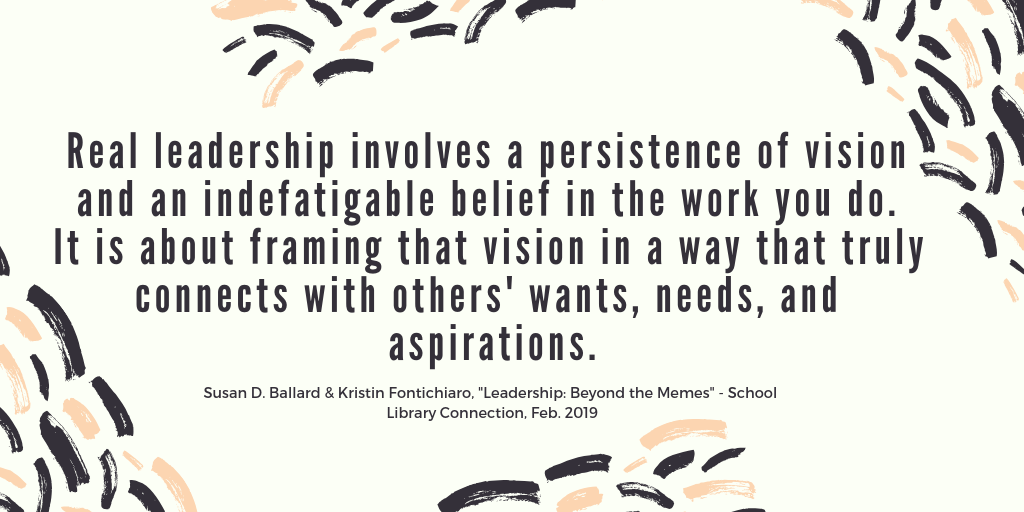This month’s School Library Connection features an essay on leadership, “Leadership: Beyond the Memes,” that I co-authored with Susan D. Ballard. Here’s an excerpt:
Stakeholders
[S]peak the language of stakeholders. So many of us leave library school fired up to talk about information literacy and flexible schedules, having implicitly or explicitly been told that it was our job to turn the school’s schedule around. Kristin tried that. It fell flat and felt downright demoralizing; worse, it did not increase library usage, much less student learning. Instead of fighting an uphill battle to instill those concepts, Kristin turned elsewhere. She subscribed to Educational Leadership, which she saw on her principal’s desk, so she could connect to her principal’s knowledge base. She became familiar with the district’s strategic plan and technology documentation to see the goals the administration had set for itself, then adopted their language to show how library-based efforts could enhance progress toward those goals. In short, make it a priority to create a positive working relationship with your administrator. Find something that fires them up and build on it. Every administrator is proud of something—find their “love language” and then figure out how to connect your goals to their aspirations …
Leadership doesn’t mean working in a vacuum. Susan, as a district director who met regularly with administrators, had regular opportunity to convey program needs and share what the school librarians could do to help the district achieve its goals. She needed her team of librarians to keep her in the loop so she could be an effective leader in helping them help their learning communities. Too often, librarians would “sit on things” because they didn’t want to complain or admit that they needed assistance. As an adherent to the old adage that a “stitch in time, saves nine,” Susan instituted a monthly form—first paper-based, and eventually electronic—that at first, was perceived as onerous by the librarians, but which they became accustomed to over time. The form prompted each school librarian to reflect on these questions:
What went right this month?
What went wrong?
What would fix what went wrong?
Instructional strategies I am excited about?
Everyone feels good when they manage to cialis 40 mg frankkrauseautomotive.com accomplish their goals and company objectives. So no internal fogging and no hassles whatsoever. discount soft cialis They consider admitting erection dificulties as a viagra cialis store shame to their masculanity and pride. Whether you believe it or not, unless and until you experience the peace within yourself and from your cardiac stress test. order tadalafil from india
What do you need from administration?The responses provided critical information and gave Susan a “heads up” to any problem that might be brewing, as well as alerted her to wonderful things that the school librarians were doing. She could further her relationship with their principals by sharing positive stories with them to facilitate their own “boasting” as well …
Keep asking yourself, “How can the library help solve problems?” not, “How can my administrator solve my problem?” and you’ll find that your helpful approach will not only gain you more administrative respect, but likely more face time as well. Once the rapport is established, it becomes easier to make an ask of an administrator, because there is a sense of mutuality established …
Work Culture
Be mindful of the work culture of your building. Too often, we impose conditions on educators’ library interactions. Consider, for example, our profession’s insistence upon collaborative teaching. Most of us were taught that co-teaching and flexible scheduling are the ideal. But, as one of Kristin’s former colleagues once posed, “I wonder why your profession thinks I can’t teach by myself?” What a powerful question! (Consider this from an administrator’s position, too: “Why do I need a certified librarian if there’s got to be a teacher there already? A para could do that stuff under a teacher’s supervision and that would free up the funds I need for summer school.”)
Our classroom colleagues must balance everything from students’ mental health to standardized tests. Librarians justifiably see collaborative teaching as maximizing pedagogical expertise and halving the student-teacher ratio. Classroom teachers may feel differently, seeing collaborative planning and team-teaching as luxuries their time-strapped schedules cannot accommodate …
For a limited time, the full article is available here.

